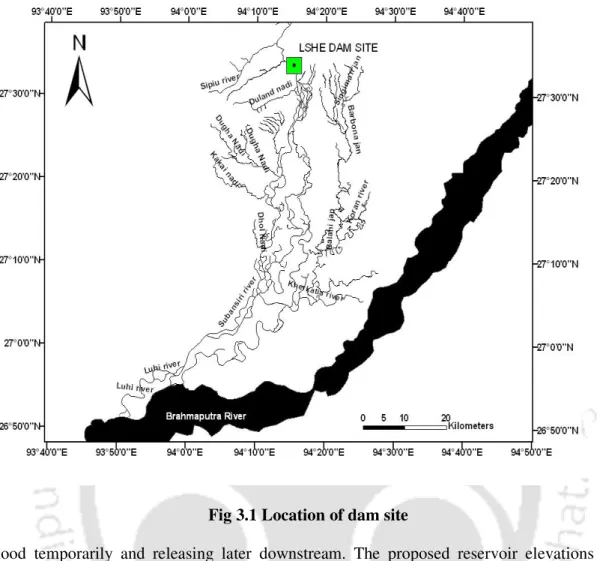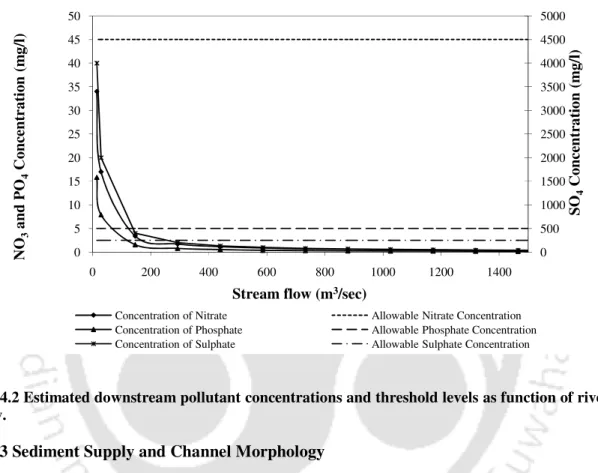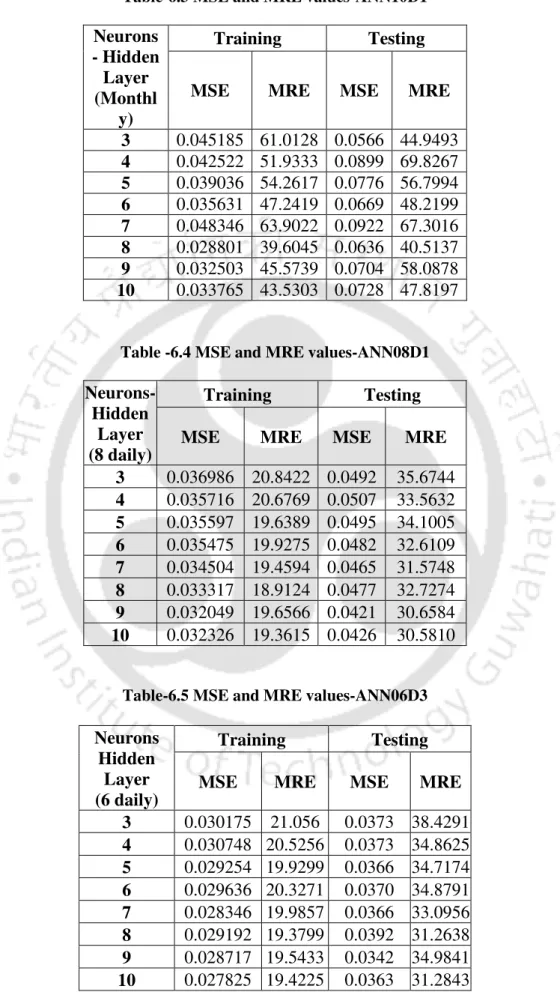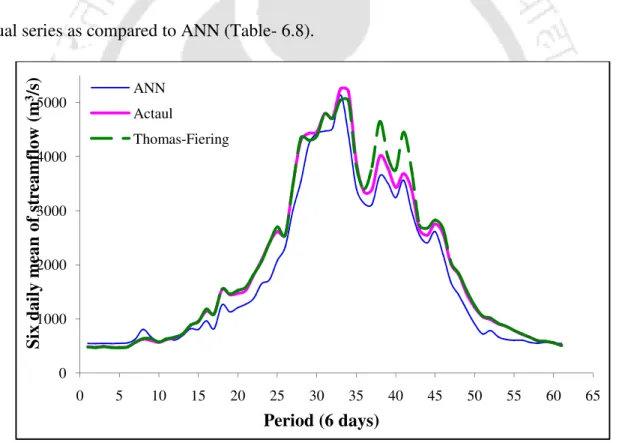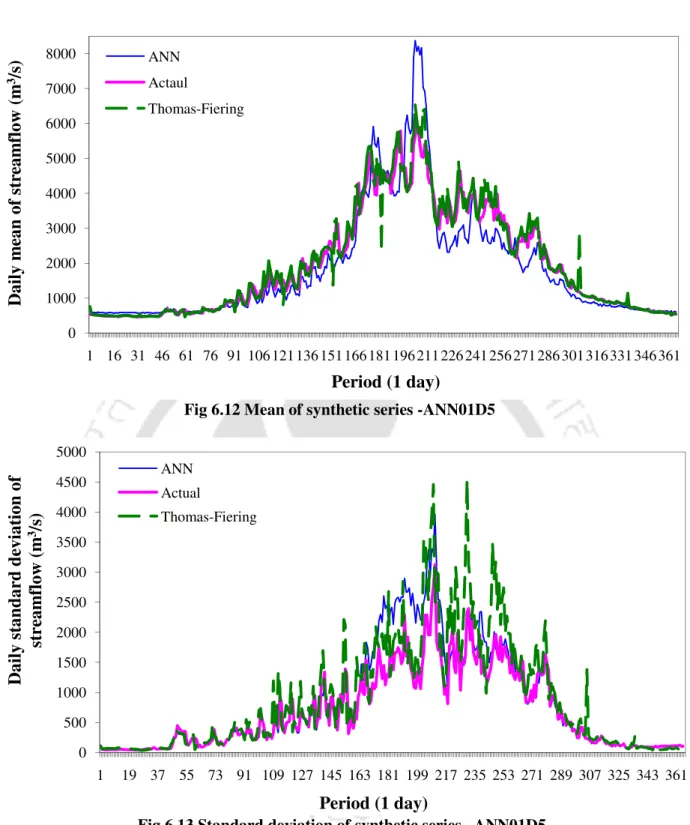The work contained in the thesis entitled “RESERVOIR OPERATION CONSIDERING DOWNSTREAM IMPACT OF A HYDROELECTRIC PROJECT” was carried out by me under the supervision of Prof. It is declared that the work contained in the thesis entitled “RESERVOIR OPERATION CONSIDERING DOWNSTREAM IMPACT OF A HYDROELECTRIC PROJECT” ” by Maya Rajnarayan Ray, Roll Number 06610407, a student of the Department of Civil Engineering, Indian Institute of Technology Guwahati for the award of the degree of Doctor of Philosophy was carried out under my supervision and that this work has not been submitted elsewhere for a degree.
Description Page No
Synthetic Stream Flow Generation 81-112
Development of Reservoir Simulation Model 113-134
ANN 10D ANN model for generating ten daily flows ANN01D ANN model for generating daily flow. ANN05D ANN model for generating five daily flows ANN06D ANN model for generating six-day flows ANN08D ANN model for generating eight daily flows ANN30D ANN model for generating monthly flow AR Auto-regressive.
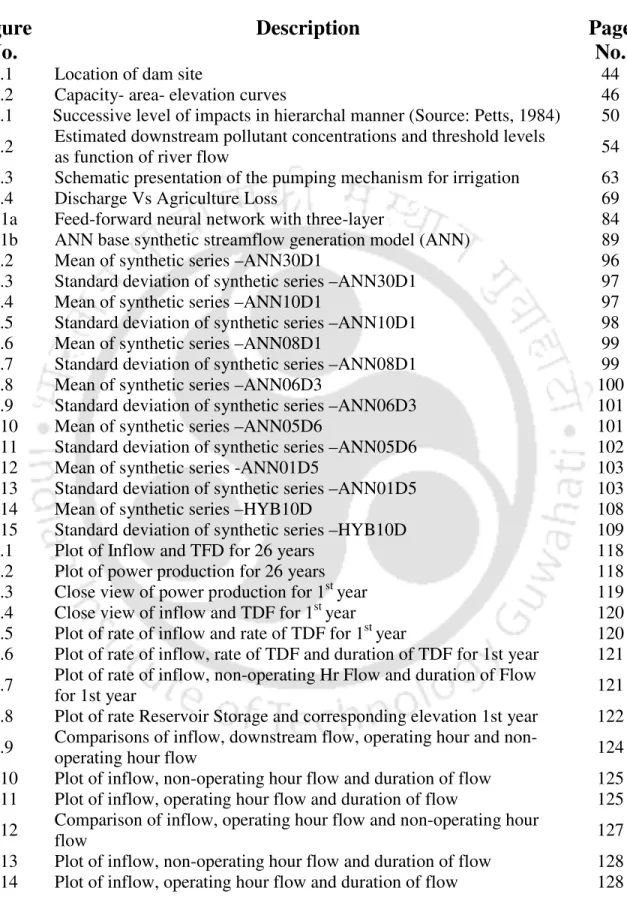
Introduction
Purpose of the Study
Therefore, an attempt has been made in this study to develop an optimal operation policy for the hydropower reservoir with due attention to minimizing downstream impacts. Against this background, it becomes necessary to develop synthetic flow series for deriving the operating policy with more confidence.
Method of Investigation
Understanding the reservoir system properly is essential before applying any optimization method to derive an optimal operating policy. Critical evaluation of the standard operating policy and the optimal operating policy considering downstream losses is performed in Chapter 9.
Conclusion
The multiple linear regression approach was used to derive the general optimal operating policy. Chapter 10, the final chapter, deals with a comprehensive conclusion and general discussion about the works carried out.
Literature Review
Introduction
Review of Previous works on Downstream Impact
They found that the maximum flooded land area, the maximum volume of water in the reservoir, and the average annual turbine flow rate were closely related. Dam size is a reflection of society's changing dependence on specific water functions/services.
Review of Previous Works on Reservoir Operation
- Introduction
- Linear Programming (LP) Models a) Deterministic LP Model
- Nonlinear Programming (NLP) Models
- Dynamic Programming (DP) Models a) Dynamic Programming (DP)
- Stochastic Dynamic Programming (SDP) Models
- Model Used as Combination of Two or More Methods
- Fuzzy Rule Based Modeling
- Genetic Algorithm (GA) Model
- Ant Colony Algorithm
This model was used for the optimization of the monthly operation of a real water supply system. Tai and Goulter (1987) introduced a heuristic iterative technique based on stochastic dynamic programming and was applied to the analysis of the operation of a three.
Previous Works on Flow Forecasting and Synthetic Stream Flow Generation
- Artificial Neural Network (ANN) Models
The performance of the neural network is compared with the statistical method of generating synthetic input. Ahmed and Sarma (2007) presented an artificial neural network to generate sets of synthetic streams of Pagladia River, Assam, India.
Conclusion
The River System and the Reservoir
- Introduction
- The River System
- Basin Description
- Climate and Rainfall
- Stream Flow
- Lower Subansiri Reservoir
- Location of Dam Site
- Purpose of the Reservoir
- Conclusion
In the upper catchments located in the Subansiri district of Arunachal Pradesh, the annual rainfall in the south is greater than in the northern areas. During the monsoon period, more than 70 percent of the rain falls over the southern half, while in the northern parts it is about 60 percent. Average lean period flow is in the region of 500m3/s and monsoon period flow is in the region of 2500m3/s.
The proposed reservoir heights and corresponding flood storage capacities for different periods are given in the table below (Table 3.1). b) Hydropower generation. Monthly ten daily flood accommodation strategy for wet period is presented in table 3.1.
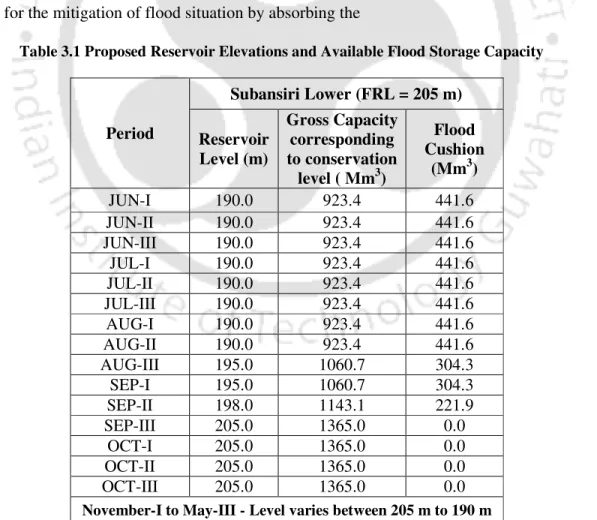
Downstream Impact
Introduction
Disturbances Induced By Dam Operation
- Hydrology
- Water Quality
- Sediment Supply and Channel Morphology
- Flood Plain Morphology
- Floodplain & Aquatic Vegetation
- Invertebrate, Fishes, Birds and Mammals
However, hydrologic regime change may also depend on the other dams in series upstream and downstream of the project in the same river basin. This project is designed as a run-of-the-river scheme primarily to meet the peak power demand. This in turn will adversely affect the environment creating various problems downstream of the dam.
Several villages and densely populated townships are also located within 20 km downstream of the dam. The contribution of these pollutants upstream of the dam can be considered negligible due to its pristine nature.
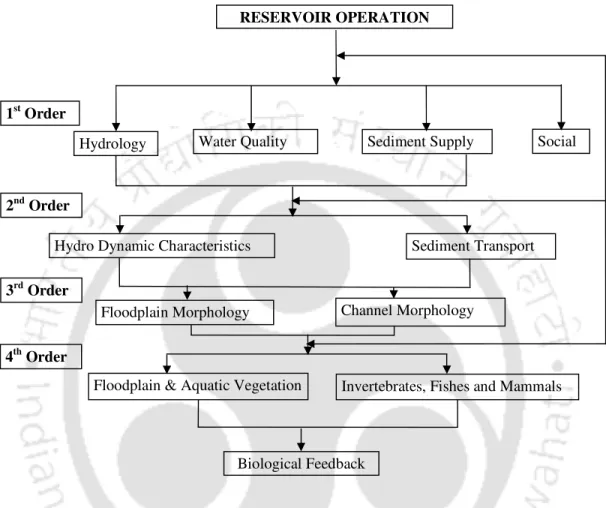
Nature of Losses in Hydroelectric Projects
- Productivity of Land and Agricultural Yield
- Fishery
- Loss of Forest
- Loss of Riparian Zone
- Reduction of Water for Domestic Use
- Poor Nutrition and Hygienic Conditions
- Loss of Employment /Livelihood and Uncertainty of Income, Poverty and Debt
- Increase in Mental Stress
Such projects can have serious consequences for the existence of certain species that depend on the watershed downstream. Furthermore, the downstream populations who depend on the forest as a primary source of food, building materials, medicine, etc., their food security and livelihoods become vulnerable. Frequent diurnal variations caused in any hydropower project can, on average, constitute a sudden inundation condition on the river bank repeatedly.
These livelihoods are highly dependent on the availability of water in streams and aquifers. On the other hand, a reduction in flow downstream can always entail a shortage of domestic water.
An Approach for Quantifying Some Significant Downstream Losses
- Assessment of Possible Agricultural Loss
- Assessment of Possible Loss from Fish Production
However, the farmer usually uses the river water during the day for agricultural purposes. Therefore, it will be worth doing an analysis of agricultural losses when the river level changes. The catchment area of the LSHE project below the dam and up to the confluence of the Brahmaputra River is 2908 km2.
On the other hand, the river's natural discharge in the lean period is in the order of 500m3/s. Next to cultivation, fishing is the dominant activity downstream of the LSHE project.
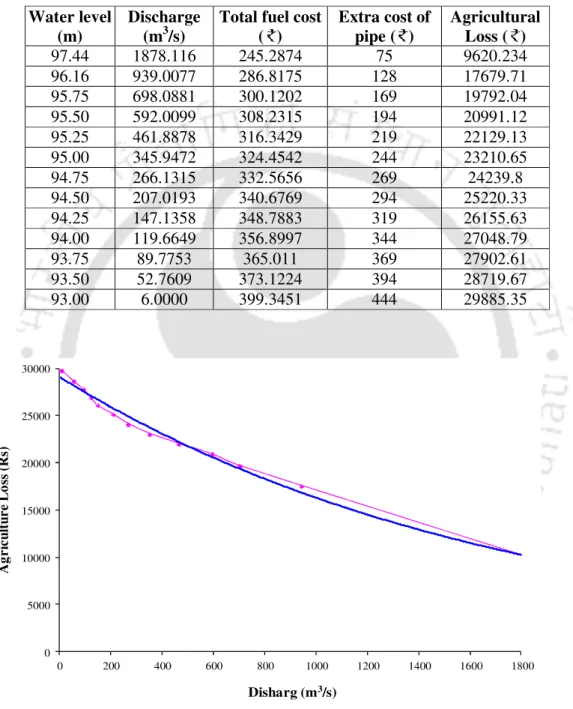
Conclusion
Problem Formulation
Introduction
Physical Feature of the Reservoir and Distributory System
Objective Functions and Constraints
- Objective Functions
- Constraints
The criterion with respect to which a design or policy is optimized, when expressed as a function of the design variable, is known as the objective function (Rao, 1996). Considering the target power demand, maximization of the power gain is taken as the objective function in this study with release as decision variable. This project is planned for peak hour power needs; therefore, maximizing the power advantage is more beneficial from the management point of view.
The major losses that directly affect the livelihood of the downstream community are considered for the assessment of the losses. The maximum storage of the reservoir at the beginning or at the end of ten days cannot be more than the storage capacity of the reservoir given in table no 3.1 in chapter 3 at the end.
Conclusion
Synthetic Streamflow Generation
- Introduction
- Thomas-Fiering Model
- Artificial Neural Network (ANN)
- Fundamentals of ANN
- Synthetic Stream Flow Generation Using ANN
- Comparison of Results of ANN, Thomas-Fiering and Actual Streamflow Series
As the number of neurons in the hidden layer increases, the trained ANN becomes more specific to the training data. A small random component calculated based on the standard deviation of the observed current flow is added to the output produced by the network (Ahmed and Sarma 2007). The comparisons of mean and standard deviation of each period of the series are shown in Fig 6.8 and Fig 6.9.
From Table 6.8 it is clear that the skewness of the whole series generated by ANN05D6 is quite close to the value of the skewness of the actual series. In this case, the value of the skewness of the series generated using the ANN01D5 model is also closer to the value of the actual historical series compared to the Thomas-Fiering model.
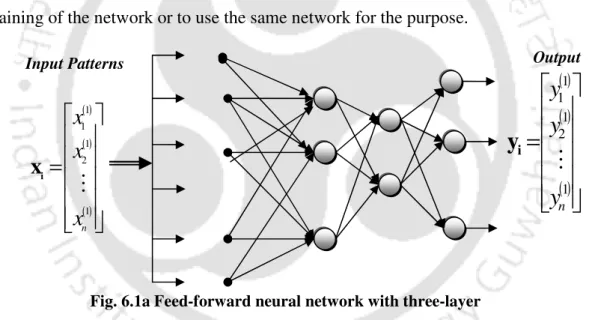
Different ANN Models Selected on The Basis of Different Parameters
Hybrid Model for Streamflow Generation
Zhang (2003) proposed a hybrid ARIMA and ANN model to take advantage of the two techniques and applied the proposed hybrid model to some real data sets. As such, the applicability of the hybrid model is gaining popularity across industries; its contribution to hydrology and water resources is limited. In the present study, an attempt has been made to develop a hybrid model that inherits the quality of the traditional Thomas-Fiering and ANN approach for synthetic streamflow generation, to achieve a better level of accuracy.
Therefore, a hybrid model was developed by exploiting the capabilities of both methods and a series with high similarity to the observed series was generated. The synthetic data generated by using the hybrid model has been used to develop reservoir operation policies.
Conclusion
The results of the study show that although the periodic mean of the Thomas-Fiering generated series follows well the periodic mean of the observed series compared to the ANN model in most time discretizations, it yields a relatively higher error in the case of periodic standard series. deviation compared to the series generated by ANN. Comparing the skewness of the series generated by Thomas-Fiering and ANN models, the skewness of the ANN-generated series is found to be closer to the skewness of the observed streamflow series for each of these time step discretizations. From the three performance criteria; (i) periodic mean, (ii) periodic standard deviation and (iii) skewness coefficient of the series, ANN was found to perform quite well for the periodic standard deviation and skewness coefficient of the series, while the performance for periodic mean was also found satisfactory and within acceptable limits .
In comparing all three statistical parameters, hybrid series generate a series that is much closer to the actual in. The skewness value of the streamflow series generated by hybrid is also closer to the skewness value of the actual series.
Development of Reservoir Simulation Model
- Introduction
- Development of Reservoir Simulation Model (RSM)
- Data Used For the Study
- The Details of Various Aspects of the RSM Model are Described Below
- RESULTS AND DISCUSSION
- Proposed Measures for Minimizing Diurnal Variation
- Comparisons of Proposed Measures
- Conclusion
Few of such possible impacts are analyzed in this study and presented in the following sections of the chapter. This leads to considerable diurnal variation downstream of the dam, which in turn leads to serious ecological problems. This study attempts to reduce the diurnal variation of the flow through different structural and non-structural methods.
The implementation of the structural measure therefore ensures the more or less similar flow in both operating hours and non-operating hours without compromising the power production. Non-structural measure-II cannot be recommended as it will not be possible to meet the peak power demand for 69.23 % of the time.
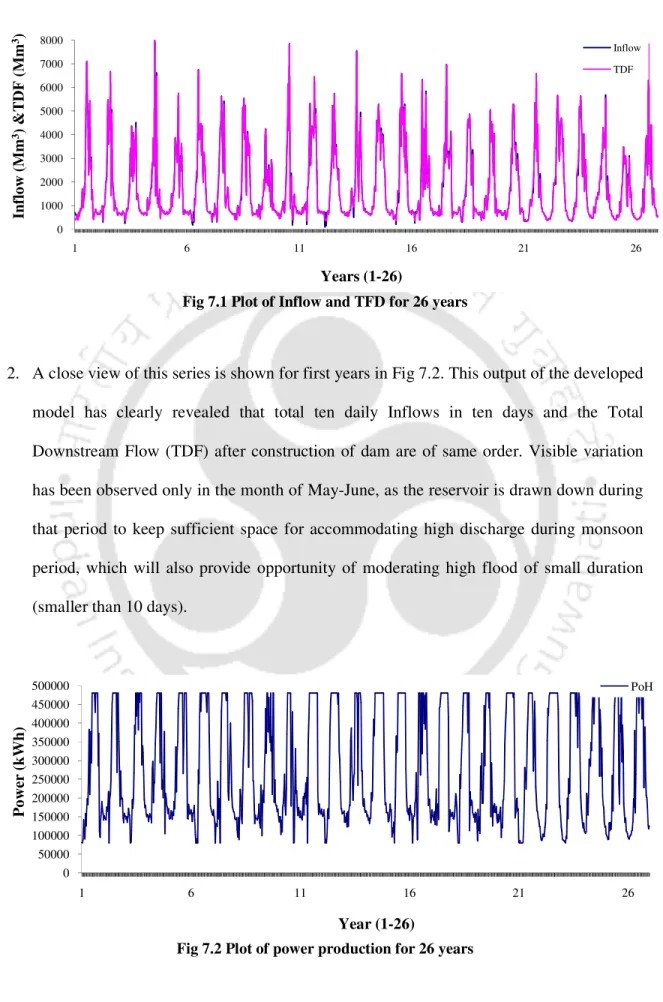
Reservoir Operation Model Using Deterministic Dynamic
Programming
- Introduction
- Model Formulation Using Deterministic DP
- Model Formulation
- Deterministic Dynamic Programming Model Application
- Discretization of Storage
- Input Data
- Model Results
- Multiple Linear Regression Model
- Results and Discussion
- Case –I (DPR1)
- Case –II (DPR2)
- Conclusion
The current study's deterministic DP model uses 100 years of synthetic series averaged over ten daily time steps. Various forms of the expressions attempted in the study are shown below in Table 8.1. The final output of the GOOP1 and their comparison with SOP1 is shown via Fig. 8.1 to Fig.
The final output of GOOP2 and their comparison with SOP2 is shown in Fig. 8.6 to Fig. Although the electricity production achieved by GOOP2 is relatively low, it is sufficient to meet the project's annual total power requirement, i.e.
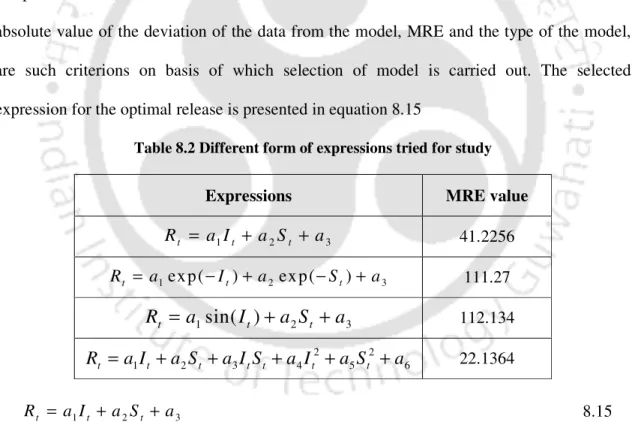
Conclusion, General Discussion and Recommendations for Further Studies
Introduction
Conclusion and General Discussion
Most of the time downstream habitats depend on the river for agriculture, fishing and many other daily activities. The performance of the ANN model for the synthetic streamflow generation of the LSHE project with the limited dataset has been investigated and its comparison has been made with the Thomas-Fiering model considering some statistical parameters viz. i) periodic mean, (ii) periodic standard deviation, and (iii) coefficient of skewness of the series. Since reservoir operation is generally performed for different time steps, the influence of the time step discretization and selection of input parameters on the synthetic streamflow generation has been evaluated using both of the above methods.
Critical evaluation of the standard operating policy and the optimal operating policy considering the downstream losses is performed based on seven different performance criteria. However, the availability of suitable land, initial capital investments and regular maintenance are some of the practical challenges in the way of implementing structural measures.
Recommendations for Further Studies
Optimization of the operation of large-scale hydropower systems.” Journal of Water Resources Planning and Management, ASCE. Multireservoir modeling with dynamic programming and neural networks.” Journal of Water Resources Planning and Management. Practical Inflow Estimation in Multiple Reservoir Systems” Journal of Water Resources Planning and Management, ASCE.
Optimal Operation of South Indian Irrigation Systems." Journal of Water Resources Planning and Management, ASCE. Comparison of Real-Time Reservoir Operation Techniques." Journal of Water Resources Planning and Management, ASCE.
APPENDIX-I
International Journal
Conferences

